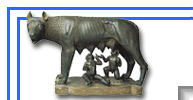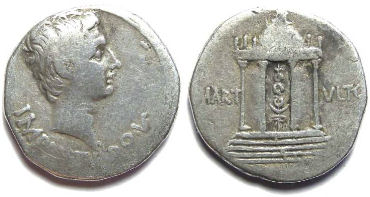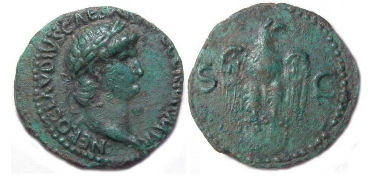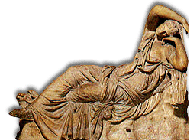 |
 |
ANCIENT ROMAN COINS - Imperial
|
|||||||||||||
|
(Reference: S=Sear Roman Coins and Their Values (2000 edtion), RSC=Roman Silver Coins, RIC=Roman Imperial Coinage, MILNE=Catalogue of Alexandrian coins; GIC=Greek Imperial Coinage by Seaby) |
|
 Augustus, 27 BC - 14 AD. Silver Cistophorus. Mars Ultor means Mars the Avenger. Augustus build this small temple to house the Legionary standard that was recovered by Augustus after it has been lost by Crassus and Antony to the Partians many years earlier. SOLD |
 Nero, AD 54 to 68.
Copper As from Perinthus mint. RARE TYPE.
SOLD
Order #
3090 |
 Magnesia
ad Sipylum in Lydia.
Caligula with Germanicus and Agrippina Sr. AE 19.
|
 Vitellius, AD 69. Silver denarius
Denomination : Silver Denarius.
Mint : Rome. Date : April to May AD 69. Reference : Sear-2196. Size : 16.7 x 17.7 mm. Weight : 3.20 grams. Grade :aVF/gF. Obverse : Head of Vitellius right, with A VITELLIVS GERMAN IMP TR P around. Reverse : Concordia seated left holding a patera and double cornucopiae, with CONCORDIA P R. SOLD
Order # 4472 |
|
(Reference: S=Sear Roman Coins and Their Values (2000 edtion), RSC=Roman Silver Coins, RIC=Roman Imperial Coinage, MILNE=Catalogue of Alexandrian coins; GIC=Greek Imperial Coinage by Seaby) |
|
ALL PRICES ARE IN US DOLLARS
CANADIAN ORDERS MUST ADD GST/HST TO ALL PRICES
FOR ADDITIONAL ANCIENT COINS WE HAVE AVAILABLE
PLEASE SEE OUR VCOINS STORE
www.vcoins.com/calgarycoinNext page of Roman Coins
Top of Page


THE JULIO-CLAUDIAN DYNASTYThe five Julio-Claudian emperors are the most famous, and the most collected of the Roman series. In 30 B.C., Octavian achieved absolute control of Rome and its territories, but the Roman Empire, along with the Julio-Claudian dynasty really began in 27 B.C. when the senate granted Octavian (the adopted son of Julius Caesar) the surname "AVGVSTVS". For the next ninety-five years the Roman Empire would be ruled by men connected with his family, although power would never pass directly from father to son. Even beyond the end of the Empire, the names of Caesar and Augustus would be associated with absolute power. The title "AVGVSTVS" would be adopted by each emperor (and "AVGVSTA" by their wives). The title "CAESAR" would be conferred, by the emperor, upon the heir (or heirs) apparent, effectively their second in command. Even into this century, the Russian ruler was known as a Czar and the German ruler as Kaiser, both derived from the title Caesar. If what you see here inspires you to seek further information on Roman history, we recommend the book Chronicle of the Roman Emperors, by Chris Scarre (ISBN 0-500-05077-5). If you cannot find it, let us know and we will see if we can get it for you. THE CIVIL WAR OF AD 68-69The turbulent reign of Nero ended with no obvious successor, throwing the Empire into a year-long period of civil unrest. The term civil war is really miss-leading, because there were few actual battles. The period started with the Revolt of Vindex which resulted in Galba being the first to grab power and gain the support of the senate. After supporting Galba, Otho expected to be granted the rank of Caesar but when it was not forthcoming, Otho assassinated Galba. Galba never fought a major battle. Otho took power on January 15, AD 69 but about three months later his army was defeated in a battle near Bedriacum and he committed suicide. Vitellius, a friend of the Julio-Claudians, and to whom Galba had given command of the legions in Lower Germany, after defeating Otho proclaimed himself Emperor. Dismayed by the fact that Vitellius appeared to be far more interested in culinary pleasures than in good government, the general Vespasian declared himself to be Emperor and had Vitellius murdered. This brought an end to one of the most turbulent years in Roman history. |
| Top of Page Copyright © 1997-2005 R & T Enterprises Ltd. |
 |